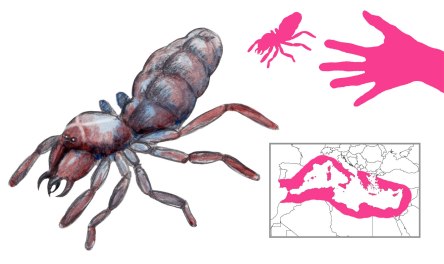Variations: Tetragnathus, Tetragnathius, Solipuga Solipaga, Salpuga, Solifuga

The Tetragnathon, “four-jawed”, is described by Classical authors as a sort of phalangion, or harmful spider. It is so fearsome that the people neighboring the Akridophagi (locust-eaters) were driven away by swarms of tetragnathons emerging after heavy rain.
Philoumenos describes two forms of tetragnathon. One is flattened, whitish, rough-legged, with two growths on its head at right angles that give the impression of four jaws. The other has a line that divides its mouth across the middle, producing four jaws. Pliny specifies that the most dangerous tetragnathon is the one with two white lines crossing in the middle of the head; the other is ashen-colored shading to white towards its abdomen. Either way the tetragnathon is deadly, biting when sat upon, but its venom can be cured by fresh spring water.
The tetragnathon is probably a solifuge, a spider-like arachnid with enormous chelicerae. It is nonvenomous, but its huge pincer-like mouthparts – easily interpreted as two sets of jaws – can deliver a painful bite.
References
Beavis, I. C. (1988) Insects and other Invertebrates in Classical Antiquity. Alden Press, Osney Mead, Oxford.
Kitchell, K. F. (2014) Animals in the Ancient World from A to Z. Routledge, Milton Park, Abingdon, Oxon.
Was there anything that didn’t kill you in Mythic Anatolia?
LikeLike
I’ve not heard of the Tetragnathon. Being driven out of your country by spiders sounds grim. The non-solipugid tetragnathon sounds a bit like a Rain Spider (Palystes spp). Big with a nasty bite. They invade houses just before heavy rain. A bit far north of it’s current range though. The plague of solipugids is very odd! They’re highly cannibalistic…HIGHLY! A plague would rapidly turn into just one enormously fat and happy individual. Intrigued to know how this event started…then avoid place if same conditions ever reoccurred. Cheers.
LikeLike
Never heard of those rain spiders :O
LikeLike
Why spring water, exactly? Is the spring itself magical or would any water do?
LikeLike
Presumably something about its purity.
LikeLike